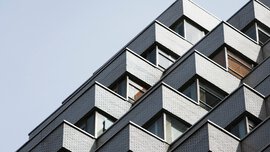Strategies for the construction of tomorrow
September 18, 2024
- Sustainability: Focus on the life cycle
- Construction standards: how little is enough?
- Holistic planning and optimization—with digital tools
According to the latest figures from the Federal Statistical Office, construction prices in Germany remained at a high level in 2023. Driven by rising material and labor costs as well as ongoing bottlenecks in the supply chains, the construction price index shows a continuous upward trend that is likely to continue in the coming years due to the economic situation and the increased requirements for sustainability and energy efficiency. The key therefore lies in taking a holistic view of all parts of the value chain—planning, construction and operation—that offers specific approaches and methods for cost efficiency and improved profitability in each phase. Approaches and solutions for this will be on display at BAU 2025 in Munich from January 13 to 17, 2025.
On the one hand, cost-effective construction requires political framework conditions, such as the package of measures to reduce construction costs of the Federal Ministry of Housing, Urban Development and Building (BMWSB). Construction research also makes an important contribution to investigating new solutions for affordable and sustainable construction, as the current publication on approaches for building owners, planners and local authorities shows. But it’s not just processes and framework conditions that need to change. The focus is also on pricing, particularly for building products in residential construction. Here, it is worth thinking outside the box and critically questioning and optimizing your own scope for action. This leads to disruptive, innovative and forward-looking models.
Focus on the life cycle
Considering the life cycle of a building ensures holistic, economical and sustainable planning. While the production price may seem attractive in the short term, the long-term costs and environmental impact can often be much higher. Furthermore, considering the life cycle of a building not only makes sense from an economic point of view, but is also essential with regard to the EU taxonomy, which promotes long-term sustainable investments. Buildings that are not constructed in an energy-efficient and environmentally friendly manner run the risk of being classified as “stranded assets” and thus losing value. A forward-looking, life cycle-oriented approach ensures not only the economic viability but also the future viability of real estate in an increasingly sustainability-oriented market.
At BAU—the world’s leading trade fair for architecture, materials and systems—the Federal Ministry of Housing, Urban Development and Building (BMWSB) is dedicating its own “ZUKUNFT BAU” stand to this topic, as Parliamentary State Secretary Sören Bartol explains: “Cost-effective construction means developing efficient and sustainable solutions along the entire life cycle of a building—from planning, to construction, to operation. This is supported by a holistic approach and optimization through digital tools and innovative business models. The serial and modular construction method plays a role here, as does the deliberate avoidance of cost-driving standards, which is supported by the BMWSB’s “Guideline and Process Recommendation for Building Type E”.”
How little is enough?
With the justification that sustainable and simple construction requires more design freedom in favor of necessary innovations, this building type is intended to overcome the tight corset of norms, superfluous standards, and bureaucratic hurdles in order to deliberately build projects that are reduced to the core of the protection objectives of the building regulations in a simple, sustainable and legally compliant manner. The launch of 19 pilot projects presented by the Bavarian State Ministry of Housing, Building and Transport, as well as various amendments to legislation such as the Lower Saxony Building Code in 2024, show that implementing the concept is already able to be implemented. “How little is enough” is also the central attitude for the renovation of existing buildings. Instead of costly measures to achieve new building standards in existing buildings, minimally invasive interventions and the use of passive design principles offer great potential. Low-maintenance construction complements this approach by creating robust structures that require little maintenance. This is both an opportunity and a challenge.
Holistic planning and optimization—with digital tools and new business models
Through the use of new planning tools and methods such as BIM (Building Information Modeling), digital twins, and artificial intelligence in design planning, digitization can help to increase efficiency. Lean management also helps to increase efficiency in the construction process and project management. Lean construction extends these principles to process optimization and increased efficiency throughout the entire construction process. New business models are also necessary for implementing cost-effective construction, as they make it possible to adapt to changing market requirements and technologies. Whether it’s in the way in which added value is generated or how trade services can be rethought: By investing in bold innovations that create new customers and markets, and thus trigger new paths of industry growth, innovative companies can not only expand their scope for action, but also change the development of their industry in the long term, as a recent study by McKinsey shows. BAU 2025 is the platform to present the latest trends, technologies and solutions for cost-effective construction, exchange ideas with leading experts, forge new partnerships, and gather inspiring ideas for a more efficient, environmentally friendly and adaptable construction industry.
Belonging images



- PR Manager
